In January we attended a Scion Exchange. At that time we obtained a number of apple scions to graft to new M-111 rootstock. However, despite the fact that January’s weather was remarkably spring-like, we opted to wait to graft our scions until our rootstocks were closer to pushing their new spring growth.
As we didn’t graft our scions immediately, the scions were stored in the refrigerator in an airtight zip-top plastic bag, and occasionally misted with water, to prevent the scions from drying out. The M-111 rootstocks were stored in the garden, heeled into soil in pots, and kept watered.
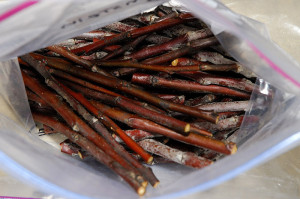
Fruit tree scions can be stored in the refrigerator for up to three months, providing they are not allowed to dry out!
Before grafting our apple scions, two weeks ago we attended a local grafting workshop hosted by the California Rare Fruit Growers. This was a valuable hands-on lesson in preparing scions and rootstocks for grafting, and everyone had a chance to practice their cutting techniques before committing to grafting their own fruit tree(s) to take home. We didn’t really need another tree, as our orchard is almost filled to capacity as it is, so of course we came home with, not one, but THREE additional apple trees. If we remain CRFG members for long, I predict we’ll either need an intervention, or more deer fence so we can expand our orchard! That or we’re going to get a lot of grafting practice!
The three additional apple varieties we obtained at the workshop are:
King David: An heirloom apple variety, reportedly originating in the 1890s as a chance seedling cross between Jonathan and either Winesap, or Arkansas Black. This apple is a good multipurpose variety, suited for eating out of hand, for cooking, juicing, and for cider-making. It is said to have flavors reminiscent of Winesap, but an appearance much closer to Arkansas Black. This variety is known for being very resistant to fire blight.
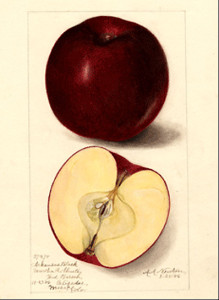
King David is similar in appearance to Arkansas Black (Image Source: Public Domain - United States Department of Agriculture)
Arlet: Also known as ‘Swiss Gourmet’, this is a relatively modern apple originating in Switzerland. It was developed at the Swiss Federal Research Station and introduced in 1958. This variety reportedly does very well in coastal California. This is apparently a cross between Golden Delicious and Idared. Although this variety was grown commercially in the United States on a small scale during the 1970s, it has since been superseded by other market varieties, and is now mostly grown in gardens. This apple stores a little longer than King David, and is good both for fresh eating, and for cooking.
Hauer Pippin: Our prize find at the workshop, this is a local heirloom apple from just a stones throw away in Aptos, California. As such, we simply couldn’t say no to this variety. Peter Hauer apparently discovered this chance seedling near a friend’s house in Aptos in the 1890s. Hauer Pippin is thought to be a cross between Yellow Bellflower and a Cox Orange Pippin. This apple was once widely grown throughout Santa Cruz county. It is a very late ripening dessert apple, and occasionally known as ‘Christmas Apple’, as it’s one of the last varieties to ripen, toward late November. Despite its popularity at the time, by 2001, most sources of Hauer Pippin had been lost due to competition from earlier ripening commercial varieties. However, Hauer Pippin is starting to make something of a local comeback. Included in Slow Food’s Ark of Taste*, this variety is tough and reliable. It’s resistant to a number of pests and diseases, perhaps most notably its thick skin reportedly makes this variety virtually immune to codling moth! As such, some small-scale organic producers are now starting to re-plant this variety due to its ease of cultivation. As a variety that is both disease resistant, and adapted to our growing region, we have high hopes for this apple.
After practicing by grafting these three new apple varieties at the workshop, last week, noticing bud-swell on our stored M-111 rootstocks, we grafted our stored apple scions from the scion exchange.

We almost waited too long to use this piece of rootstock, that was eagerly starting to push new growth
All of our apples were grafted using the cleft-grafting technique. For each scion we first cleaned the blades of the pruners with rubbing alcohol, and then trimmed any dessicated tissue from the base of the scion.
We then selected a healthy bud. Our first cut was made just above the bud, making a tapered straight, clean tapered cut toward the base.
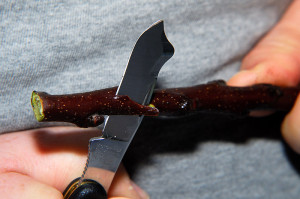
The scion is cut using a very sharp grafting knife. Note that grafting knives are available for left-handed or right-handed individuals.
The scion was rotated 180 degrees, and the cut repeated on the opposite side. The goal was to make the cut slightly thicker on the bud side, and narrower opposite the bud.
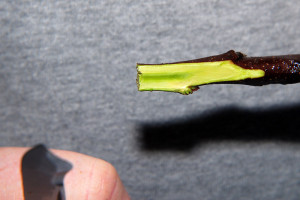
To maximize success the tapered cuts on the scion must be as straight and flat as possible
With the scion prepared, the rootstock was cut off approximately 4-5 inches above the soil line, with a clean horizontal cut. The rootstock was then split across the middle, with a cut approximately 1 inch deep.
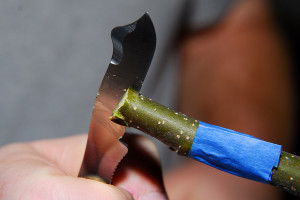
A cleft is cut into the top of the rootstock to receive the scion
Both to mark where to stop cutting, and to prevent the cut from running down the rootstock, a small piece of painters tape was applied.
The tip of the scion wedge was then inserted into the prepared rootstock.
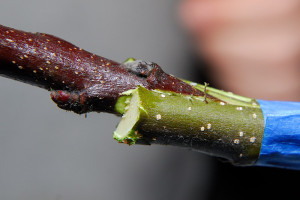
The scion is inserted into the cleft
The goal is to get the bud down into the cleft as much as possible, but most importantly the cambium from the scion must oppose the cambium of the rootstock along the outside edge of the graft.
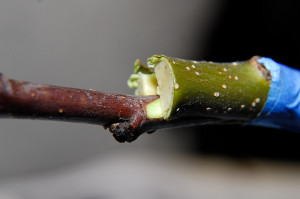
It's important to strive for at least two points of contact between the cambium of the scion, and the cambium of the rootstock
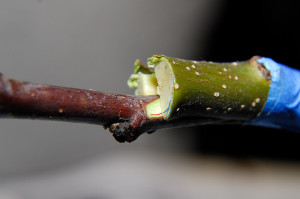
The cambium layer sits just below the 'bark'. The scion cambium is outlined in red, the rootstock cambium in blue (click to enlarge image)
The graft was then secured using an elastic band, and the joint was wrapped securely with ParaFilm.
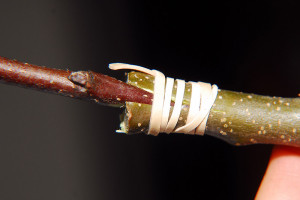
Before wrapping the graft joint with ParaFilm, an elastic band is wrapped around the graft to stabilize it
The top of the scion was then pruned. There seems to be some difference in opinion as to how much to cut, which seemed to directly correlate with the confidence of the individual performing the graft. Generally, the recommendation is to cut the scion approximately 1/2 inch above the second bud. However, feeling somewhat slightly less confident as neophyte grafters, we opted to cut above the third bud.

The tip of each scion was sealed with an elastic brush on sealant designed specifically for grafting
The tip of each scion was then sealed with an elastic grafting compound, but alternatively, the tips could have been wrapped in more ParaFilm to prevent the scions from drying out. We’ll check the grafting seal periodically and reseal if necessary in the coming weeks.
Before taking the grafted trees out to the orchard, each was carefully labeled, both with apple variety, and the rootstock used in the graft, because at this stage all grafts look remarkably the same.
We now have eight grafted apple trees: Allen’s Everlasting, Arkansas Black, Arlet, Golden Russet, Hauer, Humboldt (crab apple), King David, and Wickson (crab apple).
Now we just have to wait and see what sprouts!
————
* We now have 5 heirloom apple varieties at Curbstone Valley that are boarded into Slow Food’s Ark of Taste: Arkansas Black, Golden Russet, Hauer Pippin, King David, and Esopus Spitzenburg.

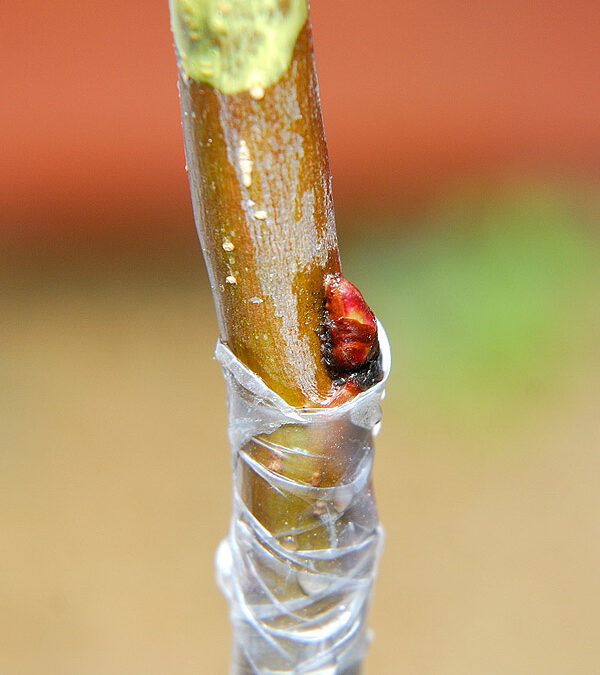
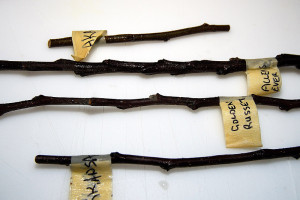
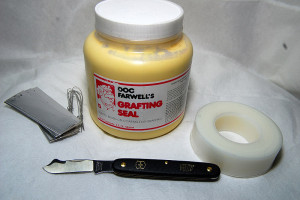



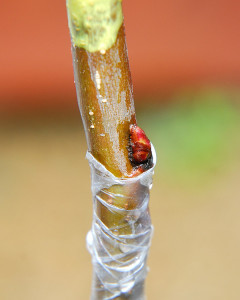







The new bud on the Wickson crabapple is announcing your success! I like the self explaining photographs of the steps involved in grafting. Photographs speak louder than words!
Thanks Helen! I’m hoping that by next year’s scion exchange, when I’ve forgotten how I did these grafts, that I can just refer to my photos for my own mini refresher course. I’m a visual learner…can you tell? 😉
Clare, How exciting and what sharp tools you use! Your photos are excellent and while I won’t be grafting, I do believe I understand the process now. gail
They are sharp…almost frighteningly so. The CRFG instructors kept joking about staying out of the blood splatter zone when watching someone demonstrate grafting! 😛
What makes a grafting knife different from, say, a French picnic knife?
Any sharp knife would work. However, other than being phenomenally sharp, a grafting knife has a unique blade shape that helps to create that angled cut on the scion wood. You ride the flat side of the knife along the scion, and the angle/bevel on the outside of the knife helps to create that taper at the end of the scion. That’s why it’s important to pick the right ‘hand’ knife when buying a grafting knife. A right-handed knife won’t work for a lefty. They’re not terribly expensive, and if you’re doing much grafting, I think they’re worth it. Honestly, I’m not sure my Leatherman knife would have worked as well.
I only grafted one time with my friend at the farm, but you laid out the instructions very well. Good informative post.
Thanks for the excellent lesson on grafting. The very clear pictures were really helpful. I haven’t tried this technique before but am considering the prospect of grafting in order to save some of older heritage apple trees we have on our property.
I love the idea of preserving the trees you have. Apple trees aren’t tremendously long-lived. If you winter prune your heritage apple trees, you can try saving some scion wood and grafting it to new rootstock. Just be sure to select last year’s growth to graft with.
Fascinating. Excellent post.
That little bud just looks so promising – I’m sure you’re out every day checking on the others. It was great to see your step by step instructions on how to graft Clare.
Since I posted this, it looks like the Arlet apple (Swiss Gourmet) is pushing growth too! 🙂
Great post! You made it look so easy to do it.I used to have Grainy Smith and Washington Red but due to my neglect, they perished! Regret it so much until now, such a waste of good plants!
Well, grafting is certainly an economical way to replace them. You can probably find local scions for free during the winter pruning season, and our rootstocks were only $3 each! Eight new apple trees for $24 (and a little work) was a great deal!
This was a fascinating post with great closeup photos, very useful. I’m attending our area scion exchange in Oregon this coming weekend. For Portland area fruit lovers, here’s the info: http://www.homeorchardsociety.org/scion_exchange/
You’ll have so much fun. Can’t wait to see what you find there.
I have Wickson crab. I got mine through Greenmantle. They have a really wide selection of super rare varieties, but I’m pretty sure they don’t offer scionwood. Still, they’re worth looking up.
I love the Greenmantle site. Lots of great information. Certainly a good resource when scions aren’t available locally.
Great post! Love grafting
A fabulous tutorial! I wish you great success; everything certainly looks good so far. Can you already taste apple pie, apple jelly, apple dumplings, apple fritters, apple sauce, dried apples, fried apples, apple cider – not to mention how gorgeous all of those trees will be in bloom. Good luck, though your skill has more to do with it!
There’s no doubt, that when all these trees are producing, I’ll be very very very busy in the kitchen! 😉 I can’t wait!
Should I ever need to graft an apple, you have made it very clear.
Very informative post! You’re way more advanced than I am, I’m still learning how to prune my apples properly. Maybe someday I’ll work up to “advanced apple care”!
Well, grafting begins with pruning 😉 Next time you prune your apple trees, save some of the wood you’ve pruned. You can practice grafting cuts before you send the twigs to the compost!
Your posts are always so full of incredibly valuable information. Even if I have no intention of grafting apple trees, I am held spell bound.
Goodness me – I only planted my first apples a few months ago. Like a few of your readers I have a looong way to go before advancing to these kinds of skills, but I am always drawn in by the clarity with which you set these tasks out Clare!